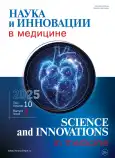Оценка давности наступления смерти методом краниоэнцефальной термометрии при однократном дискретном понижении внешней температуры
- Авторы: Недугов Г.В.1
-
Учреждения:
- ФГБОУ ВО «Самарский государственный медицинский университет» Минздрава России
- Выпуск: Том 10, № 3 (2025)
- Страницы: 218-223
- Раздел: Медицинская информатика
- URL: https://journal-vniispk.ru/2500-1388/article/view/312152
- DOI: https://doi.org/10.35693/SIM624827
- ID: 312152
Цитировать
Аннотация
Цель – разработка реализованного в формате компьютерной программы метода определения ДНС по КТ трупа в условиях его охлаждения при однократном дискретном понижении внешней температуры.
Материал и методы. Выполнено аналитическое и конечно-элементное моделирование динамики КТ при однократном дискретном понижении внешней температуры.
Результаты. Разработана математическая модель определения ДНС и неопределенности ее оценок при однократном дискретном понижении внешней температуры. Значения констант модельного уравнения и их дисперсий определены путем конечно-элементного моделирования динамики КТ в указанных условиях охлаждения. Вычислительный алгоритм данного метода определения ДНС и противопоказания к его применению реализованы на языке C# в виде программы Warm Bodies DSC.
Выводы. Разработанный метод и реализующее его приложение рекомендуются к использованию в судебно-медицинской практике для определения ДНС при однократном дискретном понижении внешней температуры.
Ключевые слова
Полный текст
Открыть статью на сайте журналаОб авторах
Герман Владимирович Недугов
ФГБОУ ВО «Самарский государственный медицинский университет» Минздрава России
Автор, ответственный за переписку.
Email: nedugovh@mail.ru
ORCID iD: 0000-0002-7380-3766
д-р мед. наук, доцент, заведующий кафедрой судебной медицины
Россия, СамараСписок литературы
- Hubig M, Muggenthaler H, Mall G. Confidence intervals in temperature-based death time determination. Leg Med (Tokyo). 2015;17(1):48-51. doi: 10.1016/j.legalmed.2014.08.002
- Schweitzer W, Thali MJ. Computationally approximated solution for the equation for Henssge's time of death estimation. BMC Med Inform Decis Mak. 2019;19(1):201. doi: 10.1186/s12911-019-0920-y
- Potente S, Henneicke L, Schmidt P. Prism - A novel approach to dead body cooling and its parameters. Forensic Sci Int. 2021;325:110870. doi: 10.1016/j.forsciint.2021.110870
- Laplace K, Baccino E, Peyron PA. Estimation of the time since death based on body cooling: a comparative study of four temperature-based methods. Int J Legal Med. 2021;135(6):2479-2487. doi: 10.1007/s00414-021-02635-7
- Wei T, Abraham J, Wang Y. Comment on the Marshall-Hoare-Henssge model for estimating the time since death. J Forensic Sci. 2023;68(2):676-681. doi: 10.1111/1556-4029.15218
- Marshall TK, Hoare FE. Estimating the time of death. The rectal cooling after death and its mathematical expression. J Forensic Sci. 1962;7(1):56-81.
- Henssge C. Death time estimation in case work. I. The rectal temperature time of death nomogram. Forensic Sci Int. 1988;38(3-4):209-236. doi: 10.1016/0379-0738(88)90168-5
- Henssge C. Rectal temperature time of death nomogram: dependence of corrective factors on the body weight under stronger thermic insulation conditions. Forensic Sci Int. 1992;54(1):51-66. doi: 10.1016/0379-0738(92)90080-G
- Althaus L, Henssge C. Rectal temperature time of death nomogram: sudden change of ambient temperature. Forensic Sci Int. 1999;99(3):171-178. doi: 10.1016/s0379-0738(98)00188-1
- Bisegna P, Henssge C, Althaus L, Giusti G. Estimation of the time since death: sudden increase of ambient temperature. Forensic Sci Int. 2008;176(2-3):196-199. doi: 10.1016/j.forsciint.2007.09.007
- Nedugov GV. Double exponential model of corpse cooling under conditions of linearly varying ambient temperature. Russian Journal of Forensic Medicine. 2021;7(4):19-28. (In Russ.). [Недугов Г.В. Двойная экспоненциальная модель охлаждения трупа в условиях линейно изменяющейся внешней температуры. Судебная медицина. 2021;7(4):19-28]. doi: 10.17816/fm429
- Nedugov GV. New computer technologies to determine postmortem interval by the Henssge method. Russian Journal of Forensic Medicine. 2021;7(3):152-158. (In Russ.). [Недугов Г.В. Новые компьютерные технологии определения давности наступления смерти по методу Henssge. Судебная медицина. 2021;7(3):152-158]. doi: 10.17816/fm406
- Henssge C, Madea B. Estimation of the time since death in the early post-mortem period. Forensic Sci Int. 2004;144(2-3):167-75. doi: 10.1016/j.forsciint.2004.04.051
- Nedugov GV. Estimation of the postmortem interval by the method of finite element modeling of postmortem heat transfer in human head. Science & Innovations in Medicine. 2022;7(3):179-185. [Недугов Г.В. Оценка давности наступления смерти методом конечно-элементного моделирования посмертного теплообмена головы. Наука и инновации в медицине. 2022;7(3):179-185]. doi: 10.35693/2500-1388-2022-7-3-179-185
- Schenkl S, Muggenthaler H, Hubig M, et al. Automatic CT-based finite element model generation for temperature-based death time estimation: feasibility study and sensitivity analysis. Int J Legal Med. 2017;131(3):699-712. doi: 10.1007/s00414-016-1523-0
- Subramaniam JS, Hubig M, Muggenthaler H, et al. Sensitivity of temperature-based time since death estimation on measurement location. Int J Legal Med. 2023;137(6):1815-1837. doi: 10.1007/s00414-023-03040-y
- Ullrich J, Weiser M, Shanmugam Subramaniam J, et al. The impact of anatomy variation on temperature based time of death estimation. Int J Legal Med. 2023;137(5):1615-1627. doi: 10.1007/s00414-023-03026-w
Дополнительные файлы









